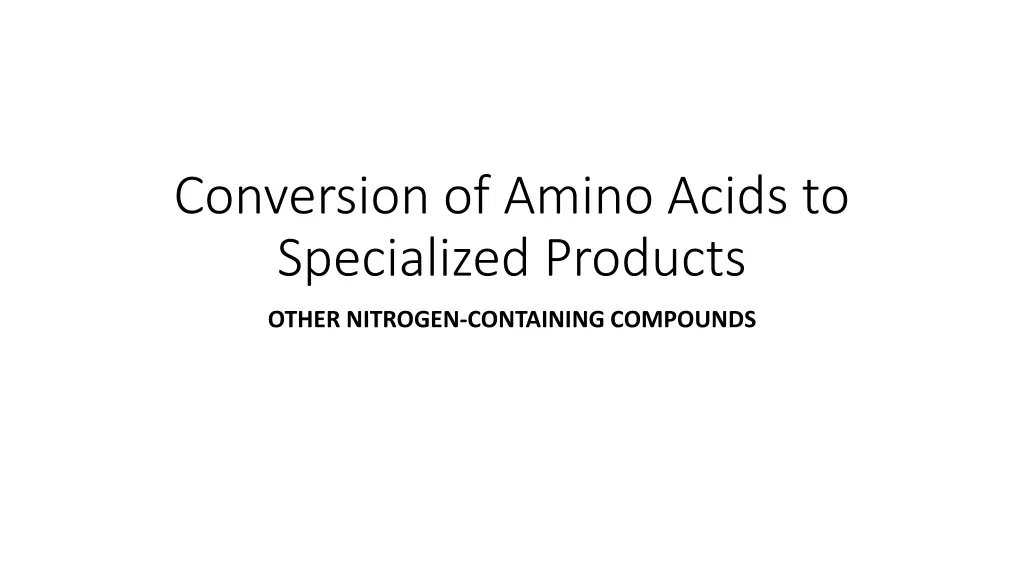
Synthesis and Functions of Catecholamines, Creatine, and Histamine
Discover the conversion of amino acids to specialized products like catecholamines, the synthesis of dopamine, norepinephrine, epinephrine, and creatine, along with the role of histamine. Catecholamines act as neurotransmitters and metabolic regulators, while creatine provides rapid energy exchange in muscle cells. Histamine plays a key role in immune responses and allergic reactions.
Uploaded on | 1 Views
Download Presentation

Please find below an Image/Link to download the presentation.
The content on the website is provided AS IS for your information and personal use only. It may not be sold, licensed, or shared on other websites without obtaining consent from the author. If you encounter any issues during the download, it is possible that the publisher has removed the file from their server.
You are allowed to download the files provided on this website for personal or commercial use, subject to the condition that they are used lawfully. All files are the property of their respective owners.
The content on the website is provided AS IS for your information and personal use only. It may not be sold, licensed, or shared on other websites without obtaining consent from the author.
E N D
Presentation Transcript
Conversion of Amino Acids to Specialized Products OTHER NITROGEN-CONTAINING COMPOUNDS
Catecholamines Catecholamines Dopamine, norepinephrine, and epinephrine (adrenalin) are biologically active amines that are collectively termed catecholamines . Dopamine and norepinephrine function as neurotransmitters in the brain and the autonomic nervous system. Norepinephrine and epinephrine are also synthesized in the adrenal medulla. Functions: Outside the nervous system, norepinephrine and its methylated derivative, epinephrine act as regulators of carbohydrate and lipid metabolism. Norepinephrine and epinephrine are released from storage vesicles in the adrenal medulla in response to fright, exercise, cold, and low levels of blood glucose. They increase the degradation of glycogen and triacylglycerol, as well as increase blood pressure and the output of the heart. These effects are part of a coordinated response to prepare the individual for emergencies, and are often called the "fight-or-flight" reactions.
Synthesis of Synthesis of catecholamines catecholamines: : The catecholamines are synthesized from tyrosine, as shown in (Figure 1) Tyrosine is first hydroxylated by tyrosine hydroxylase to form 3,4- dihydroxy- phenylalanine (dopa) . The enzyme is abundant in the central nervous system, the sympathetic ganglia, and the adrenal medulla, and is the rate- limiting step of the pathway. Dopa is decarboxylated in a reaction requiring pyridoxal phosphate to form dopamine, which is hydroxylated by the copper-containing dopamine -hydroxylase to yield norepinephrine. Epinephrine is formed from norepinephrine by an N-methylation reaction using S-adenosylmethionine as the methyl donor.
Creatine Creatine Creatine phosphate (also called phosphocreatine), the phosphorylated derivative of creatine found in muscle, is a high-energy compound that can reversibly donate a phosphate group to ADP to form ATP (Figure 2). Creatine phosphate provides a small but rapidly mobilized reserve of high-energy phosphates that can be used to maintain the intracellular level of ATP during the first few minutes of intense muscular contraction. [The amount of creatine phosphate in the body is proportional to the muscle mass.] Synthesis: Creatine is synthesized from glycine and the guanidino group of arginine, plus a methyl group from S-adenosyl-methionine (Figure 2). Creatine is reversibly phosphorylated to creatine phosphate by creatine kinase, using ATP as the phosphate donor. [Note: The presence of creatine kinase in the plasma is indicative of tissue damage, and is used in the diagnosis of myocardial infarction .
Histamine Histamine Histamine is a chemical messenger that mediates a wide range of cellular responses (allergic and inflammatory reactions, gastric acid secretion, and possibly neurotransmission in parts of the brain). A powerful vasodilator, histamine is formed by decarboxylation of histidine in a reaction requiring pyridoxal phosphate(Figure 3). The action of histamine have important therapeutic applications. synthesis of histamine (Figure 3) Synthesis of Histamine
Serotonin Serotonin Serotonin (5-hydroxytryptamine), is synthesized and stored at several sites in the body (intestinal mucosa, platelets and in the central nervous system (Figure 4). Serotonin is synthesized from tryptophan, which is hydroxyllated by tryptophanhydroxylase. The product, 5-hydroxytryptophan, is decarboxylated to serotonin. Serotonin has multiple physiologic roles, including pain perception, affective disorders, and regulation of sleep, temperature, and blood pressure.
E. Melanin E. Melanin Melanin is a pigment that occurs in eye, hair, and skin. It is synthesized by melanocytes. Its function is to protect underlying cells from the harmful effects of sunlight. The first step in melanin formation from tyrosine is a hydroxylation to form dopa, catalyzed by the copper-containing enzyme tyrosine hydroxylase (Figure 5). (Figure 5) Synthesis of Melanin
